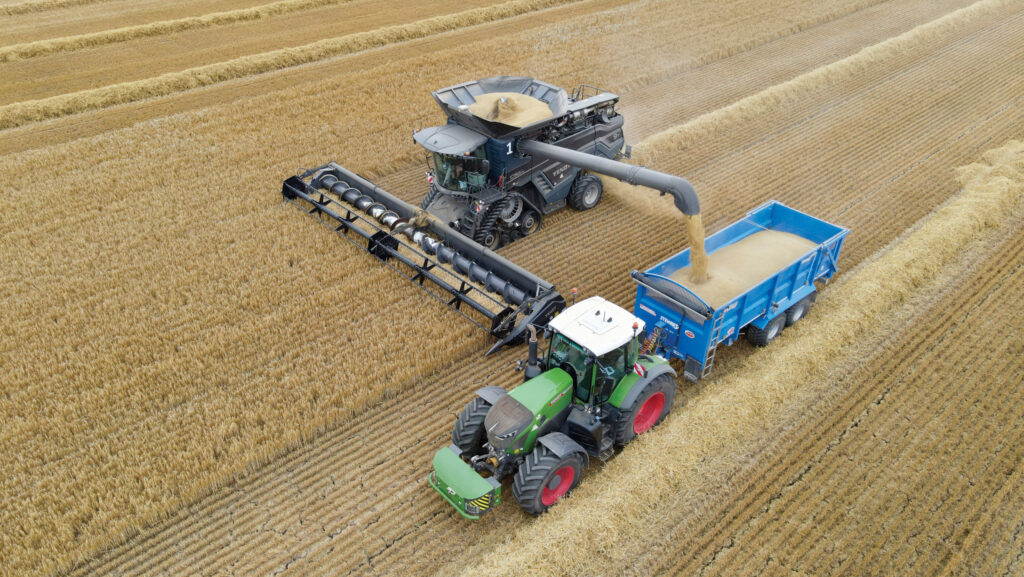Harvest 2025: OSR yields well but wheats are mixed
 © Submitted by Mini Seed Man
© Submitted by Mini Seed Man Harvest is gathering pace across England, with oilseed rape yielding well and coming in dry and clean.
Wheat yields are mixed, but grain quality is notably high, with strong specific weights and high proteins.
See also: Why Essex grower is expanding Scope wheat area this autumn
Kent
At Weald Granary, near Maidstone, intake is steadily progressing, albeit with logistical challenges.
“We’re still loading old crop out, so it’s created a bit of a juggle,” managing director says John Smith.
While yields this season are under average, grain quality is proving exceptional.
“Wheat samples look like some of the best we’ve seen in years,” says John. “Straw yields are down, but protein is significantly high; between 12.5% and 15.5%.”
Specific weights are also strong, at 72-82kg/hl, although light land has struggled more than heavier soils.
Unlike last season, ergot has been low to none, reflecting the dry season.
Oilseed rape is coming in dry, with oil contents about 0.5% up on average, and yields reported up to 4.5t/ha.
“We’ve had 2,000-3,000t of Kingsbarn hybrid barley so far, with a specific weight of 68kg/hl and above,” he adds.
The store has taken in 600t of Planet spring barley, which appears pale, with small seed, but a high nitrogen content.
“One farmer has already started on oats and beans. Whereas previously there was a clear cutting order, this season the weather has meant people are just cutting whatever is fit.”
Worcestershire
Further north, harvest is in full swing across Worcestershire.
“It’s all going on, with winter barley, oilseed rape, spring barley, and even wheat coming in,” says Kim Wells, managing director at Acorn Arable.
“Remarkably, I have one farm about to start cutting beans.”
Winter barley yields are around 6.2t/ha, with specific weights at 66-71kg/hl.
Planet spring barley is yielding below average, at around 4.9t/ha, but it is still making malting quality, with screenings well within spec – 99% retention on the 2.5mm sieve.
Wheat is looking promising, with early milling samples coming in at 7.41t/ha and 76-78kg/hl.
Hagbergs are typically over 300 seconds, with protein consistently above 14%.
“It’s turning out better than we could have hoped for,” Kim adds.
“The dry conditions are pushing crops along rapidly, and while yields are mixed, quality, particularly in milling wheat, is shaping up well.”
County Durham and Northumberland
In the North, about 10,000t of barley is already in store at GrainCo, says Tom Carmichael, farm trader.
“Most of our growers have now finished barley, although some were caught out by the weather before they could get it all,” he says.
Yields have generally been better than expected, and specific weights are strong.
“It’s a step up from last year, which was close to disaster for many.”
The early start caught some by surprise.
“Given the lack of spring rain, farmers were bracing for poor results, but most have been pleasantly surprised by both yield and quality.”
Oilseed rape is just coming in, and early signs are encouraging.
“Barley and oilseed rape have come in dry, which is a big bonus for growers looking to cut drying costs.”
Wheat is still to come, and all eyes are on how the dry conditions may have affected final grain fill.
Suffolk
Over near Debenham, it’s been a positive start to harvest for Ed Nesling at Winfield Farms.
Across the 75ha of oilseed rape,moisture levels were 7.5-8.5%, with yields looking encouraging.
The Attica yielded 4.1t/ha, while Maverick did 3.8t/ha.
“The Maverick was not drilled until September, compared to Attica in August, and it really struggled with pigeon pressure,” says Ed.
“Despite that, the crop looked good all year, even though we only had 60mm of rain from March to July.”
While the oilseed rape was cut 10-14 days earlier than usual, it still outperformed previous years.
“There was no flea beetle pressure this year, meaning it outgrew early worries,” he adds.
Looking ahead, Ed still has 240ha of wheat to combine, and expects yields to be about 20% below average.
“We’ve tried a bit, but the top grains are rock solid from the sun, while the lower ones are still doughy.”

